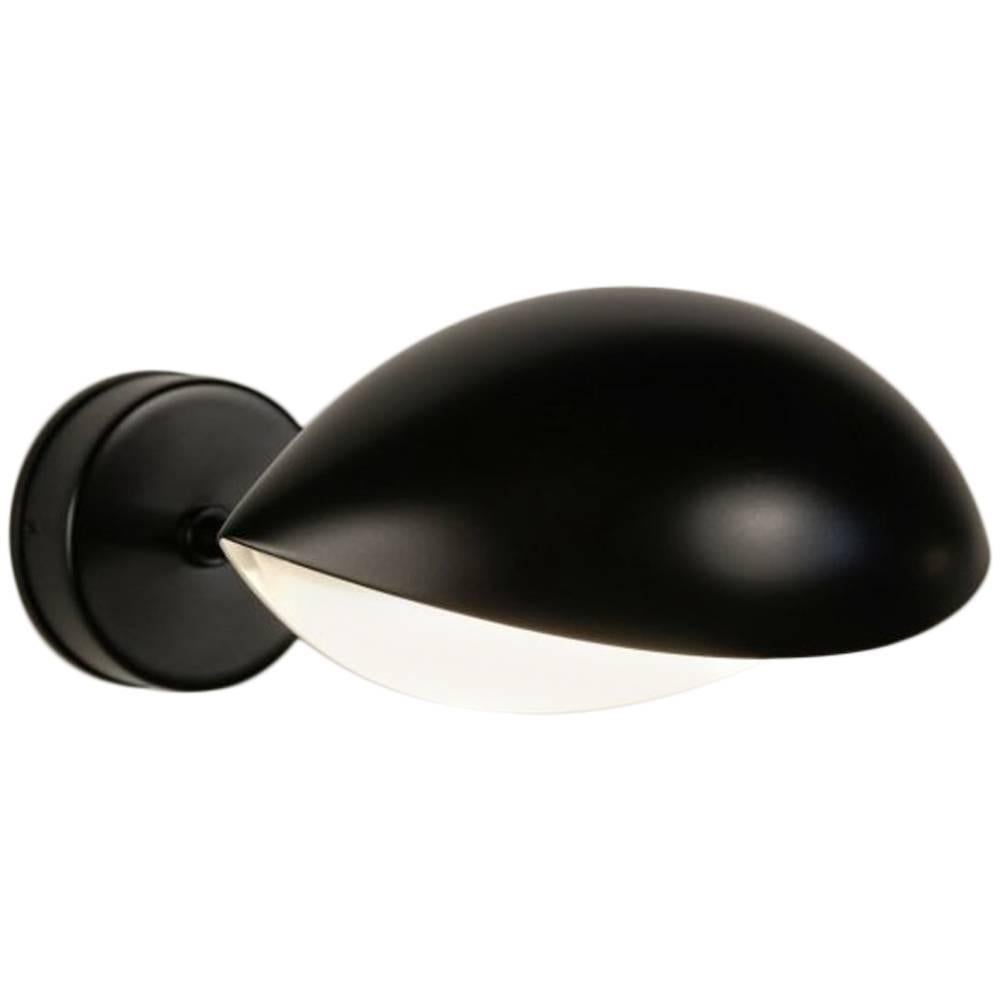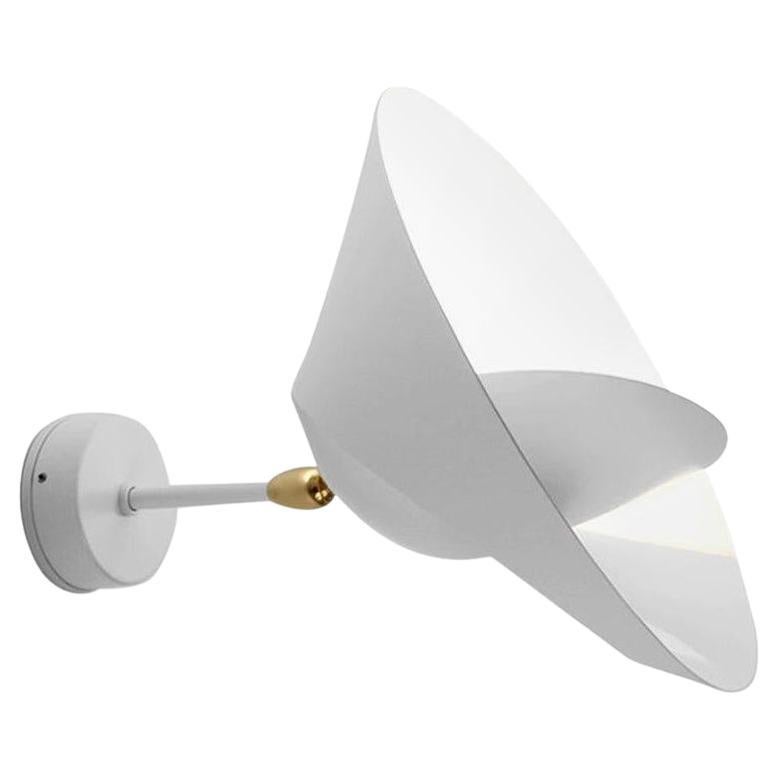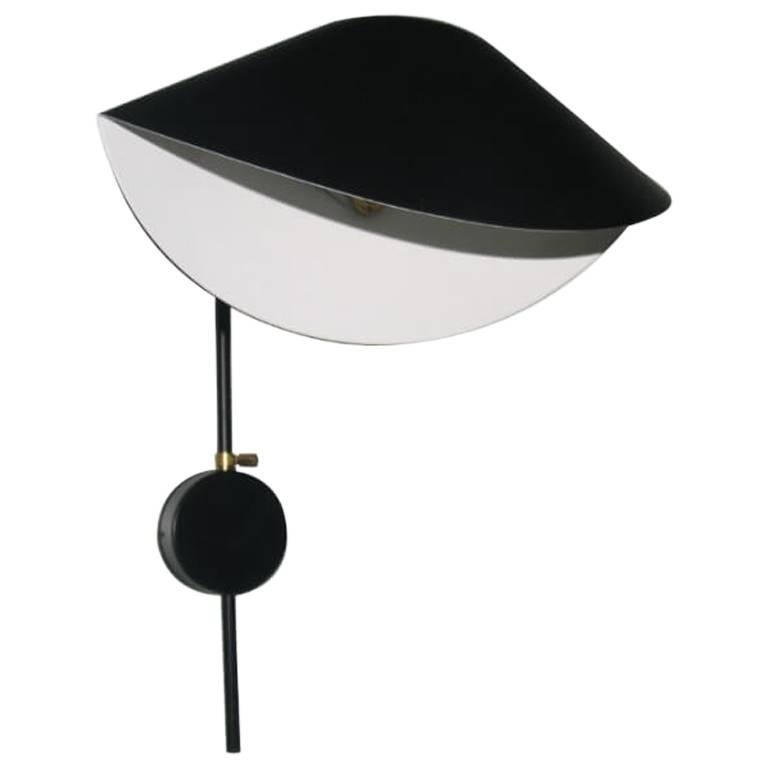Items Similar to Sconce attributed to Mouille Serge
Video Loading
Want more images or videos?
Request additional images or videos from the seller
1 of 7
Sconce attributed to Mouille Serge
About the Item
Sconce
To take care of your property and the lives of our customers, the new wiring has been done.
If you want to live in the golden years, this is the Wall light that your project needs.
We have specialized in the sale of Art Deco and Art Nouveau styles since 1982.
If you are looking for sconces to match your ceiling lighting, we have what you need.
Pushing the button that reads 'View All From Seller'. And you can see more objects to the style for sale.
Serge Mouille
Instantly recognizable by their long slender armatures and domed, ovoid shades, the best-known floor lamps and other lighting fixtures of Serge Mouille have become emblems of the organic design of the mid-20th century. Along with Jean Prouvé, Mathieu Matégot and others, Mouille brought a fresh, modern aesthetic to metalwork, one of the most tradition-bound mediums in the decorative arts.
Mouille (pronounced: MWEE) was born to a working Parisian family. At age 15, he took up studies in the metalworking atelier of that École des Arts Appliqués, under the tutelage of the goldsmith and sculptor Gabriel Lacroix. After graduating, in 1941, Mouille worked in Lacroix’s studio and began teaching at his alma mater four years later.
In the early 1950s, bothered by the preponderance of new Italian lamps and chandeliers on the market and consumed with the belief that fixtures by Gino Sarfatti and others were unnecessarily complex, Mouille opened a lighting-design workshop. He quickly won commissions from several French schools and libraries. In 1956, the influential Paris gallerist Steph Simon — who also promoted Prouvé, Charlotte Perriand and Isamu Noguchi — began to show Mouille designs, introducing his work to private collectors. Mouille would continue making handcrafted lighting fixtures at a slow but steady pace until 1964, when he stopped working to begin a long course of treatment for tuberculosis. When it was completed, Mouille returned to teaching at the École des Arts Appliqués for the remainder of his career.
With the biomorphic shades and long armatures of his fixtures, Mouille created one of the most engaging and idiosyncratic lighting aesthetics of his time. Though often described as “insect-like,” his pieces have more in common with the fluid, buoyant forms in the paintings of Jean Arp. (Mouille designed several cylindrical or columnar lamps; though highly collectible, those are interesting outliers in his body of work.)
As with Prouvé’s folded metal forms and Matégot’s perforated steel, Mouille brought a novel lightness and energy to metal furnishings. Since Mouille’s designs found renewed popularity in the early 2000s, licensed re-editions of his pieces are being produced. The disparity in price between vintage and current-day Mouille pieces is great. Older works — identification tip: the interior white reflective enameling has a yellowish cast — cost $20,000 to $40,000, and newer pieces go for 10 to 20 percent less than that. As you will see on these pages, Serge Mouille created icons of 20th century design — at once sleek, suave and friendly — that belong in any modern decor.
Why are there so many antiques in Argentina?
In the 1880 – 1940 there was a grate wave of immigration encouraged by the periods of war that were taking place.
1st World War took place between 1914 and 1918
2nd World War took place between 1939 and 1945
The immigrants options were New York or Buenos Aires. Tickets were cheap and in Buenos Aires they were welcomed with open arms, as it was a country where everything was still to be done.
Argentina was the country of new opportunities, labour was needed and religious freedom was assured, in many cases the of the family travel first until they were settled and then the rest of the family members join them.
In the immigrant museum “Ellis Island Immigrant Building” in New York you can se the promotional posters of the boats that would take them to a new life.
Between the years 1895 and 1896, Argentina had the highest DGP (gross domestic product) per capita in the world according to the Maddison Historical Statistics index, this situation arose due to the large amount of food being exported to European countries, which were at war.
The Argentinean ships left the port of Buenos Aires with food, but they returned with furniture, clothes and construction elements, (it´s common to see this the old buildings of the historic neighbourhood of San Telmo, the beams with the inscription “Made in England)”, as well as many markets that were built in Buenos Aires, such us the San Telmo Market, whose structure was brought by ship and afterwards assembled in 900 Defensa Street.
With the great influence of European immigrants living in the country, the children of the upper classes travelled to study in France, resulting in the inauguration of “La Maison Argentinienne”, on 27th of June 1928, in the international city of Paris, which hosted many Argentinians that were studying in Frace.
It´s the fourth house to be built after France, Canada and Belgium, being the first Spanish-speaking one. Still in place today (17 Bd Jourdan, 75014, Paris, France). Many of the children of these wealthy families who attended international art exhibitions, museums and art courses abroad, took a keen interest in the European style. This is why Buenos Aires was at the time referred as “The Paris of South America”.
Between the years 1890 and 1920 more than a hundred Palaces were built on Alvear Avenue the most exclusive avenue in Buenos Aires. Today some of these palaces have been transformed into museums, hotels and embassies.
In the year 1936, the Kavanagh building was inaugurated, it was the tallest reinforced concrete building in South America.
During 1994 the American Society of Civil Engineers distinguished it as an “international engineering milestone”, and it´s now considered a World Heritage of Modern Architecture.
At the time was common to hire foreign architects such as Le Corbusier, who visited Buenos Aires/Argentina in 1929 and in 1948 he drew up the blueprints for a house built in La Plata City (which was declared a World Heritage Site).
In 1947, the Hungarian architect Marcelo Breuer designed “Parador Ariston” in the seaside city of Mar del Plata. After an Argentinean student at Harvard University convinced him to come to Argentina. He worked on an urban development project in the Casa Amarilla, area of La Boca.
The Ukrainian architect, Vladimiro Acosta, arrives in Argentina in 1928 and worked as an architect until que moved to Brazil.
Antonio Bonet, a Spanish architect who worked with Le Corbusier in Paris, arrives in Argentina in 1937, where he carried out several architectural works and in 1938 designs the well-known BFK chair.
Andres Kálnay, of Hungarian origin, made around 120 architectural masterpieces, among which the former Munich brewery stands out, he even made the furniture’s design.
The German architect, Walter Gropius, director of the Bauhaus, lived in Argentina, where he wrote articles for “Sur” magazine and founded in Buenos Aires, an architectural firm with Franz Möller, who was also an architect, where he built two houses.
At the same time several famous designers decided to immigrate to Argentina, among them we can find the well-known French designer, Jean-Michel Frank, who arrived in the country in 1940 and also worked for the Rockefeller family.
Special pieces were made, which were sold exclusively in the country, such as the well-known German company “WMF”, who sold their products by catalogue, which were chosen by the ladies of high society in the list of wedding gifts, as well as the pieces designed by Christofle.
The Swiss sculptor Alberto Giacometti, made special pieces for Argentinean mansions.
In 1904 the first Jansen branch outside Paris was established in Buenos Aires, as the Argentinean clientele demanded a large amount of furniture, from the end of the 19th century to the mid-20th century.
In 1970, the brand Rigolleau Argentina made pieces authorised by Lalique.
The brands Maple and Thompson also set up shop in the country.
The French plastic artist, Marcel Duchamp moved to Argentina in 1918-1919.
Glass signed Gallé, Charder, Leverre, Schneider, Muller and other French firms. They were bought in flower shops and were given to ladies with beautiful floral arrangements.
Some furniture manufacturers travelled to international fairs and bough the patterns to produce the furniture in Argentina, such as the furniture firm Englander and Bonta, who bought the patterns ins Italy.
It is worth mentioning that in Argentina we have the largest community of Italians outside of Italy, as it is estimated that 70 percent of the inhabitants have at least one Italian descendant, followed by Spanish immigrants.
The most Important furniture stores in Argentina:
Comte is founded in 1934 (under the direct management of Jean Michel Frank in 1940).
Nordiska (Swedish company established in 1934).
Churba in 1960, a company that brought foreign designers to present their furniture in the country:
Denmark: (Arne Jacobsen, Finn Juhl, Bender Madsen, Ejner Larsen, Poul Kjaerholm, Hans Wegner)
Sweden: (Hans Agne Jakobsson, Gustavsberg)
United States: (Herman Miller)
Finland: (Lisa Johansson, Folke Arstrom, Tapio Wirkkala, Alvar Aalto, Timo Sarpaneva)
Swedish Factory: (Orrefors)
Italy: (Littala, Vico Magistretti, Emma Gismondi, Gae Aulenti, Angelo Mangiarotti, Elio Martinelli, Gianna Celada, Angelo Mangiarotti, Mario Bellini, Carlo Scarpa)
Finland: (Olivia Toikka)
Plata Lappas (Lappas Silver): a goldsmith shop founded in 1887 in Argentina by Alcibiades Lappas of Greek origin.
In 2019, in Argentina took place “the Art Deco world congress”, in which we participated as hosts invited by Geo Darder, founder of the Copperbridge – Foundation, in which prominent people from all over the world attended to learn about Art Deco in Argentina.
Argentina currently has more than 100 Art Deco buildings and another 90 Art Nouveau buildings throughout the city of Buenos Aires.
Argentina is a country that has not been involved in many wars, which is why it has been a refuge for works of art and antiques from different periods of time, unlike European countries. That is way many collectors, museums and antique dealers from all over the world visit it, you should not miss the opportunity to visit this great country.
Laura Guevara Kjuder, architect.
- Attributed to:Serge Mouille (Designer)
- Dimensions:Height: 11.97 in (30.4 cm)Width: 29.14 in (74 cm)Depth: 4.34 in (11 cm)
- Power Source:Hardwired
- Voltage:220-240v
- Lampshade:Included
- Style:Space Age (Of the Period)
- Materials and Techniques:
- Place of Origin:
- Period:
- Date of Manufacture:1930
- Condition:Rewired. Wear consistent with age and use.
- Seller Location:Ciudad Autónoma Buenos Aires, AR
- Reference Number:
About the Seller
5.0
Vetted Seller
These experienced sellers undergo a comprehensive evaluation by our team of in-house experts.
Established in 1982
1stDibs seller since 2022
21 sales on 1stDibs
Typical response time: <1 hour
- ShippingRetrieving quote...Ships From: Ciudad Autónoma Buenos Aires, Argentina
- Return PolicyThis item cannot be returned.
More From This SellerView All
- France Table Lamp, 1955, attributed to Mouille SergeBy Serge MouilleLocated in Ciudad Autónoma Buenos Aires, CTable lamp Country: France To take care of your property and the lives of our customers, the new wiring has been done. If you want to live in the golden years, this is the table lam...Category
Vintage 1950s French Space Age Table Lamps
MaterialsBronze
- Table Lamp, 1955, France Attributed to Mouille SergeBy Serge MouilleLocated in Ciudad Autónoma Buenos Aires, CTable lamp Country: France To take care of your property and the lives of our customers, the new wiring has been done. We have specialized in the sale of Art Deco and Art Nouveau a...Category
Vintage 1920s French Space Age Table Lamps
MaterialsAluminum, Bronze
- Sconce Art Deco, 1930, "Attributed to Gilbert Poillerat", FranceBy Gilbert PoilleratLocated in Ciudad Autónoma Buenos Aires, CStyle: Art Deco Material: iron and wood Country: France We have specialized in the sale of Art Deco and Art Nouveau and Vintage styles since 1982. If you have any questions we are at your disposal. Pushing the button that reads 'View All From Seller'. And you can see more objects to the style for sale. "Attributed Gilbert Poillerat" There have been many important French designers associated with Art Deco and through the 1930’s, ’40’s and beyond who worked in wrought iron. One usually thinks of Edgar Brandt, Raymond Subes, and Paul Kiss. For quite a while, when Art Deco was enjoying its first flush of recognition in the 1970’s, Gilbert Poillerat remained relatively unknown. This would soon change as the natural progression of design exploration began to move into the 1930’s and beyond, and Poillerat would emerge as one of the most original and important designers of his time. Gilbert Poillerat was born in 1902 in a small town in France that, oddly, had three names – Mer, Loir et Cher. Like many other furniture designers, he attended the famed École Boulle, where he trained as a metal chiseler and engraver, graduating in 1921. Following his graduation, he worked with arguably the best and most influential wrought-iron master – Edgar Brandt. He worked for Brandt for over seven years in both design and production. There can be no doubt that this time was hugely important, not only in furthering his training and perfecting his technique, but also exposing him to the new ideas that had blossomed forth during the Art Deco movement, when wrought-iron escaped the constraints of tradition that had kept it static for so long. In 1927, Poillerat left Brandt, and began working for Baudet, Donon and Roussel, a firm specializing in construction frameworks. He was placed in charge of their decorative iron-work division, which produced tables...Category
Vintage 1930s French Art Deco Wall Lights and Sconces
MaterialsIron
- Sconce Italian, 1960, Materials, Acrylic and BronzeLocated in Ciudad Autónoma Buenos Aires, CSconce Materia: acrylic and bronze Country: Italian We have specialized in the sale of Art Deco and Art Nouveau and Vintage styles since 1982. If you have any questions we are at yo...Category
Vintage 1960s Italian Space Age Wall Lights and Sconces
MaterialsBronze
- Sconce Italian, 1960, Materials: Acrylic and WoodLocated in Ciudad Autónoma Buenos Aires, CSconce Materia: acrylic and wood Country: Italian. We have specialized in the sale of Art Deco and Art Nouveau and Vintage styles since 1982. If you have any questions we are at you...Category
Vintage 1960s Italian Space Age Wall Lights and Sconces
MaterialsWood, Acrylic
- 2 Sconces in Chrome and Crystal, Year, 1950, SwedenLocated in Ciudad Autónoma Buenos Aires, C2 Sconces Year: 1950 Materials: chrome and crystal To take care of your property and the lives of our customers, the new wiring has been done. If you want to live in the golden years...Category
Vintage 1950s Swedish Space Age Wall Lights and Sconces
MaterialsCrystal, Chrome
You May Also Like
- Rare Single Wall Sconce Attributed to Serge MouilleBy Serge MouilleLocated in Los Angeles, CARare single wall sconce by Serge Mouille. Designed and manufactured in France, circa 1950. Incredibly rare anatomical wall sconce with two points of...Category
Vintage 1950s French Mid-Century Modern Wall Lights and Sconces
MaterialsSteel, Aluminum, Metal
- Serge Mouille - Eye SconceBy Serge MouilleLocated in Stratford, CTThe Mouille "œil" or Eye Sconce is named for the shape of the shade. This simple yet practical lamp is suitable for many applications due to its diminuative...Category
21st Century and Contemporary French Mid-Century Modern Wall Lights and ...
MaterialsSteel, Aluminum
- Serge Mouille - Saturn SconceBy Serge MouilleLocated in Stratford, CTA partial cut allows the outer edge to bend revealing a sculpted ring encircling a central cone reflector to both diffuse and project light into the room. The result is reminiscent o...Category
21st Century and Contemporary French Mid-Century Modern Wall Lights and ...
MaterialsSteel, Aluminum
- Serge Mouille - Flame Wall SconceBy Serge MouilleLocated in Stratford, CTDESCRIPTION: An elegant twist of metal results in a lamp that illuminates upwards while creating playful shadows through the elongated metal with tapered ending. Totally unique, this...Category
21st Century and Contemporary French Mid-Century Modern Wall Lights and ...
MaterialsSteel, Aluminum
- Serge Mouille - Black Antony SconceBy Serge MouilleLocated in Stratford, CTThis sconce incorporates the "moule" or mussel shell shade, simple and natural in design. The shade is connected by a brass swivel and supported on a bent, rotating arm attached to t...Category
21st Century and Contemporary French Mid-Century Modern Wall Lights and ...
MaterialsAluminum, Steel
- Serge Mouille - Black Antony SconceBy Serge MouilleLocated in Stratford, CTThis sconce incorporates the "moule" or mussel shell shade, simple and natural in design. The shade is connected by a brass swivel and supported on a bent, rotating arm attached to t...Category
21st Century and Contemporary French Mid-Century Modern Wall Lights and ...
MaterialsAluminum, Steel
Recently Viewed
View AllMore Ways To Browse
Ship To Italy
Aesthetic Vintage Space
Lights Sconce Sale
Outside Sconce
Antique Lamps Sconces
Antique Sconce Midcentury
Large Decorative Sconces
Factory Sconce
Mid Century Modern Flower Sconce
Hotel Sconce
Street Sconces
Aged French Sconce
French Country Sconce
Outside Wall Sconces
French Country Lighting Sconces
Floral Glass Sconces
Glass Floral Sconces
Ceiling Lights Vintage Style





